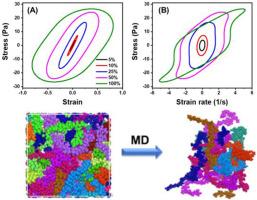Uncovering the effect of molecular structure on the rheology of welan gum by viscoelastic characterization, density functional theory and molecular dynamics simulation
IF 11
1区 农林科学
Q1 CHEMISTRY, APPLIED
引用次数: 0
Abstract
The heteropolysaccharide of welan gum has been widely utilized as a rheological modifier in various industrial fields due to its high viscosity and robust tolerance towards shear, temperature, pH, and salinity. However, the research on its solution rheology is inadequate, particularly regarding the impact of its chemical structure on solution properties. Herein, we investigate the rheology of three welan samples with different substitution patterns at concentrations ranging from 0.5% to 2.0%. The impact of side group type, content, and molecular size on flow behavior, dynamic viscoelasticity, thixotropy, and yield behavior is elucidated. Welan gum with mannose side groups exhibits characteristics of a thixotropic yield stress fluid with the highest viscosity, viscoelasticity, thixotropy, and yield stress. In contrast, the other two welan gums lacking mannose substituents display only weak thixotropy and low yield stress at higher concentrations. The creep and stress bifurcation tests have demonstrated that the solid-liquid transition of welan gum with mannose side groups depends on the magnitude and duration of applied stress, which can be interpreted through two critical stress values. The rheological properties of welan gum are influenced by its fine structure and molecular size in combination. In addition, density functional theory calculations and molecular dynamics simulations have further provided insight into the fine structure-function relationship of welan gum, indicating that monosaccharide side groups increase molecular polarity and enhance hydrogen bonding. This work provides a fundamental understanding of the structure-function relationship of welan gum for tailoring its versatile applications.

通过粘弹性表征、密度泛函理论和分子动力学模拟揭示分子结构对惠兰胶流变性能的影响
威兰胶杂多糖具有高粘度、耐剪切、耐温度、耐pH、耐盐等特性,已广泛应用于各种工业领域。然而,对其溶液流变学的研究还不充分,特别是对其化学结构对溶液性质的影响的研究。在此,我们研究了三种不同取代模式的welan样品在0.5%至2.0%的浓度范围内的流变性。阐明了侧基类型、含量和分子大小对流动行为、动态粘弹性、触变性和屈服行为的影响。具有甘露糖侧基的惠兰胶具有最高粘度、粘弹性、触变性和屈服应力的触变屈服应力流体特征。而缺乏甘露糖取代基的其他两种胶在较高浓度下仅表现出较弱的触变性和较低的屈服应力。蠕变和应力分岔试验表明,甘露糖侧基威兰胶的固液转变取决于外加应力的大小和持续时间,这可以通过两个临界应力值来解释。威兰胶的流变性能受其精细结构和分子大小的共同影响。此外,密度泛函理论计算和分子动力学模拟进一步揭示了welan胶的精细结构-功能关系,表明单糖侧基增加了分子极性,增强了氢键。这项工作提供了对welan胶结构-功能关系的基本理解,以定制其多功能应用。
本文章由计算机程序翻译,如有差异,请以英文原文为准。
求助全文
约1分钟内获得全文
求助全文
来源期刊

Food Hydrocolloids
工程技术-食品科技
CiteScore
19.90
自引率
14.00%
发文量
871
审稿时长
37 days
期刊介绍:
Food Hydrocolloids publishes original and innovative research focused on the characterization, functional properties, and applications of hydrocolloid materials used in food products. These hydrocolloids, defined as polysaccharides and proteins of commercial importance, are added to control aspects such as texture, stability, rheology, and sensory properties. The research's primary emphasis should be on the hydrocolloids themselves, with thorough descriptions of their source, nature, and physicochemical characteristics. Manuscripts are expected to clearly outline specific aims and objectives, include a fundamental discussion of research findings at the molecular level, and address the significance of the results. Studies on hydrocolloids in complex formulations should concentrate on their overall properties and mechanisms of action, while simple formulation development studies may not be considered for publication.
The main areas of interest are:
-Chemical and physicochemical characterisation
Thermal properties including glass transitions and conformational changes-
Rheological properties including viscosity, viscoelastic properties and gelation behaviour-
The influence on organoleptic properties-
Interfacial properties including stabilisation of dispersions, emulsions and foams-
Film forming properties with application to edible films and active packaging-
Encapsulation and controlled release of active compounds-
The influence on health including their role as dietary fibre-
Manipulation of hydrocolloid structure and functionality through chemical, biochemical and physical processes-
New hydrocolloids and hydrocolloid sources of commercial potential.
The Journal also publishes Review articles that provide an overview of the latest developments in topics of specific interest to researchers in this field of activity.
 求助内容:
求助内容: 应助结果提醒方式:
应助结果提醒方式:


